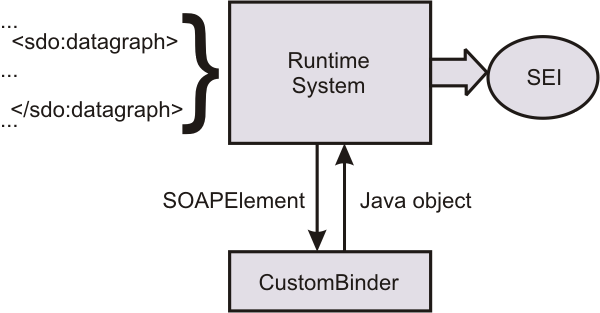Custom data binders for JAX-RPC applications
A custom data binder is used to map XML schema types with Java objects. Custom data binders provide bindings for XML schema types that are not supported by the current Java API for XML-based Remote Call Procedure (JAX-RPC) specification.
The custom data binder defines serialize and deserialize methods to convert between a Java object and a SOAPElement interface. A custom data binder is added to the runtime system and interacts with the web services run time using a SOAPElement. Unlike conventional deserializers, custom data binders do not rely on the low-level parsing events from the run time to build the Java object, such as Simple API for XML (SAX). Instead, the run time builds the custom data binder by rendering the incoming SOAP message into a SOAPElement. The SOAPElement containing the message is passed to the customer data binder. For example, if the incoming message contains a Service Data Object (SDO) datagraph, the runtime system processes as follows:
- The runtime system recognizes the <sdo:Datagraph> code.
- The run time queries the type mapping system to locate the custom data binder for the datagraph data, for example SDOCustomBinder.
- A SOAPElement is created that represents the incoming SDO datagraph.
- The run time passes the SOAPElement to the SDOCustomBinder.
Within the deserialized method, the SDOCustomBinder extracts the content from the SOAPElement and builds a concrete DataGraph object with a commonj.sdo.DataGraph type.

When a Java object is serialized, a similar process occurs. The run time locates a custom data binder and converts the Java object to a SOAPElement. The runtime serializes the SOAPElement to the raw message that is transported in the output stream.
Example of an XML schema defined by the SDO specification:
<xsd:schema
xmlns:xsd="http://www.w3.org/2001/XMLSchema"
xmlns:sdo="commonj.sdo"
targetNamespace="commonj.sdo">
<xsd:element name="datagraph" type="sdo:DataGraphType"/>
<xsd:complexType name="DataGraphType">
<xsd:complexContent>
<xsd:extension base="sdo:BaseDataGraphType">
<xsd:sequence>
<xsd:any minOccurs="0" maxOccurs="1"
namespace="##other" processContents="lax"/>
</xsd:sequence>
</xsd:extension>
</xsd:complexContent>
</xsd:complexType>
<xsd:complexType name="BaseDataGraphType" abstract="true">
<xsd:sequence>
<xsd:element name="models" type="sdo:ModelsType" minOccurs="0"/>
<xsd:element name="xsd" type="sdo:XSDType" minOccurs="0"/>
<xsd:element name="changeSummary"
type="sdo:ChangeSummaryType" minOccurs="0"/>
</xsd:sequence>
<xsd:anyAttribute namespace="##other" processContents="lax"/>
</xsd:complexType>
<xsd:complexType name="ModelsType">
<xsd:sequence>
<xsd:any minOccurs="0" maxOccurs="unbounded"
namespace="##other" processContents="lax"/>
</xsd:sequence>
</xsd:complexType>
<xsd:complexType name="XSDType">
<xsd:sequence>
<xsd:any minOccurs="0" maxOccurs="unbounded"
namespace="http://www.w3.org/2001/XMLSchema" processContents="lax"/>
</xsd:sequence>
</xsd:complexType>
<xsd:complexType name="ChangeSummaryType">
<xsd:sequence>
<xsd:any minOccurs="0" maxOccurs="unbounded"
namespace="##any" processContents="lax"/>
</xsd:sequence>
<xsd:attribute name="create" type="xsd:string"/>
<xsd:attribute name="delete" type="xsd:string"/>
</xsd:complexType>
</xsd:schema>
WebSphere Application Server defines the CustomBinder interface that implements concrete custom bindings for a specific XML schema type.
The custom binding provider is used to import the custom bindings into the run time. To learn how to plug our custom data binders into the WSDL2Java command-line tool for development, read about custom binding providers. We can also read about usage patterns for deploying custom data binders to learn more about how to deploy the provider package to your runtime, as well as the roles involved in the custom binding process.